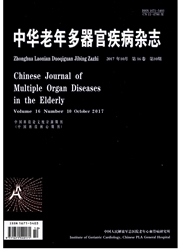

 中文摘要:
中文摘要:
目的探讨慢性间歇低氧(CIH)对大鼠颏舌肌细胞超微结构及线粒体功能的影响及脂联素(Ad)的干预作用。方法健康雄性Wistar大鼠39只,随机分成健康对照组(A)、CIH组(B)、CIH加Ad干预组(C),每组13只。A组大鼠保持呼吸空气,B组与C组均接受CIH环境(CIH8h/d,共5周),但C组同时经静脉注射Ad,10gg/次,2次/周,5周。于实验终止(第35天)时测定并比较各组大鼠血清Ad浓度、颏舌肌超微结构(电镜下)、颏舌肌线粒体3态呼吸率(ST3)、4态呼吸率(ST4)、线粒体复合物Ⅰ活性、线粒体复合物Ⅳ活性。结果(1)B组血清Ad浓度为(1108+112)μg/L,与A组相比显著降低[(2240±121)μg/L,P〈0.01];C组Ad浓度[(1889±119)μg/L]高于B组,但仍显著低于A组(均P〈0.01)。(2)B组大鼠颏舌肌纤维结构损伤,肌原纤维结构紊乱,肌丝溶解、消失,线粒体水肿、嵴断裂,部分线粒体空泡改变或溶解消失,C组病理改变较轻。(3)大鼠颏舌肌细胞线粒体的ST3和RCR均于B组最低,A组最高。三组间ST3、RCR两两比较差异显著(均P〈0.01);A,B,C3组ST4分别为(15.2±2.5),(12.9±2.0),(13.5±2.3)μmol/(min·g),其中A,B两组比较有统计学差异(P〈0.05),C组虽较B组有升高趋势,但无统计学差异。A,C两组比较亦无统计学意义。(4)线粒体复合物Ⅰ,Ⅳ浓度以B组[分别为(35.7±1.7)mmol/(min·g),(2.4±0.1)μmol/(min·g)]最低,C组[分别为(37.2±1.9)mmol/(min·g),(2.5±0.1)μmol/(min·g)]及A组[分别为(39.0±1.3)mmol/(min·g),(2.8±0.1)gmol/(min·g)]依次增高。A,B两组比较差异非常显著(P〈0.01),C组与B组和A组比较亦差异显著(均P〈0.05)。结论CIH可致大鼠血清Ad水平降低,且能显著损伤颏舌肌超微结构?
 英文摘要:
英文摘要:
Objective To investigate the effect of chronic intermittent hypoxia (CIH) on rat genioglossal ultrastructure and mitochondrial function as well as the intervention role of adiponectin (Ad). Methods Thirty-nine healthy male Wistar rats were randomly divided into three groups: normal control group(A), CIH group(B) and CIH+Ad group(C), with 13 rats in each group. Rats in group A kept breathing normal air, while rats in both groups B and C were fed in the same CIH environment (CIH 8 h/day for successive 5 weeks). However, rats in group C were given intravenous Ad supplement at the dosage of 10 p.g, twice a week for 5 weeks. At the end of experiment (day 35), the serum Ad levels, the genioglossal ultrastructure, and the mitochondrial State 3 respiratory rates(ST3), state 4 respiratory rates (STn)and activities of respiratory chain complexes I and IV in mitochondrion of genioglossal cells were compared among different groups. Results (1) Serum Ad level was significantly lower in group B than in group A [(1108_+112) vs (2240_+1210) ~tg/L, P〈0.01]. Serum Ad level in group C [(1889_+1190) Ix g/L] was significantly higher than that in group A, but lower than that in group B (P〈0.01). (2) In group B, there were significant genioglossal ultrastructural pathological changes, such as myofibrile discontinuities, lysis of myofilament, edema of mitochondria and disruption of cristae, vacuolus and lysis of some mitochondria. These pathological changes were less significant in group C. (3) The genioglossal mitochondrial ST3, ST4, respiratory control ratio (RCR) were the lowest in group B but highest in group A, with a significant difference in ST3 and RCR among three groups (all P〈0.01). The mitochondrial ST4 was (15.2±2.5), (12.9±2.0), and (13.5±2.3) p.mol/(min · g)in groups A,B and C,respectively, with a statistical difference between groups A and B (P〈0.05), but no difference between groups C and B, or groups A and C
 同期刊论文项目
同期刊论文项目
 同项目期刊论文
同项目期刊论文
 期刊信息
期刊信息
